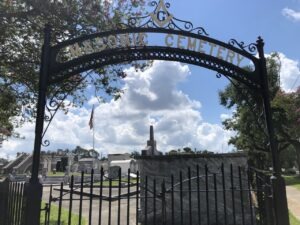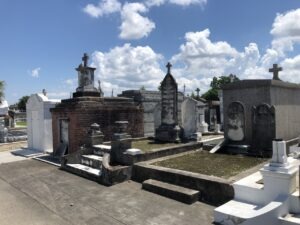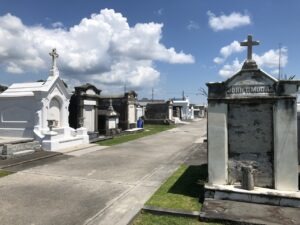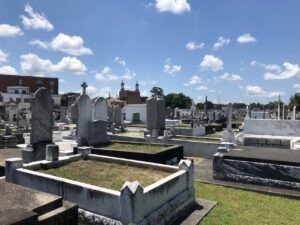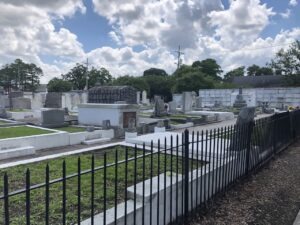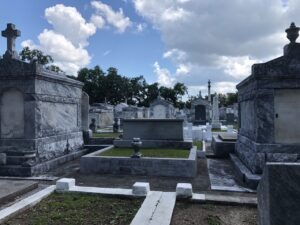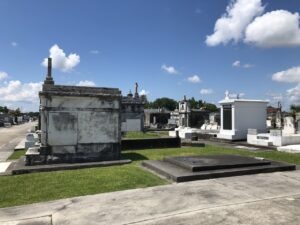One of the many distinctive aspects of New Orleans is its approach to cemeteries. Rather than just rows of headstones, the burial grounds of the Crescent City often feature unique, aboveground tombs. These structures create an atmosphere of something not unlike a neighborhood. This is so much the case that the great American humorist, Mark Twain, referred to the cemeteries of New Orleans as “cities of the dead.”
While in New Orleans, I knew the trip wouldn’t be complete without visiting at least one of its historic cemeteries. Thankfully, I was able to tour a few and learned that there have actually been different approaches to burial there. My pictures in this post were taken at: the Masonic Temple Cemetery No. 1, St Patrick Cemetery No. 1, and St Patrick Cemetery No. 2. They are all in close proximity to each other and to other cemeteries.
The Masonic Temple Cemetery dates back to 1865, when it was founded by the Grand Lodge of the State of Louisiana. It has a number of striking tombs, as you can see from the pictures.
The parish of St. Patrick’s Church founded the St. Patrick’s Cemeteries in 1841. There are three in total. No. 1 features mostly in-ground burials, which was favored by the parishioners at that time. As the congregation changed over the years, the preference shifted to aboveground burials, as can be seen in No. 2.
When touring the New Orleans cemeteries, I encountered some different types of burial approaches:
Family Tombs
These are probably what most people think of when it comes to New Orleans cemeteries. They are standalone, stone structures, usually with a family name on the front. For a burial, the deceased will be placed inside the vault where the body must remain, undisturbed, for at least a year and a day. Due to the Louisiana climate, the interiors of these tombs get extremely hot, thus speeding up the decomposition process. When another family member passes away, the remains of the earlier interred person are pushed to the back of the vault where they’ll fall through an opening into a lower chamber, known as a caveau. (Alternatively, I’ve read that the remains would be collected into a labeled bag, which would then be placed in the caveau.) The newly deceased will then be interred and the process will repeat. Eventually, the caveau can contain the remains of many members of a family.
Coping Graves
A coping is a stone frame around a grave. In New Orleans, the walls of a coping can descend up to a few feet beneath ground level and up to a few feet above. The area within it will be filled with earth. Thus, these burials may also be referred to as raised bed graves. The top of a coping may be a stone slab, gravel, or grass. If it’s especially tall, there may be a stone step in front of it. The purpose of some copings may have been to keep the burial above the water table.
Wall Vaults
These are also known as oven vaults. The approach is similar to the family tombs discussed above, but they have many more chambers. If a family experienced a number of deaths within the same year, such that their family tomb couldn’t accommodate the bodies, space in a wall vault might be rented. After a year and a day, the remains would be moved from the wall vault to the caveau of the family tomb. Wall vaults may be seen around the borders of a cemetery.
Unique and atmospheric, the cemeteries of New Orleans have a character all their own. It’s no wonder that they made such an impression on Mark Twain. These cities of the dead still captivate visitors today as they did in the past.
Locations
Masonic Cemetery
400 City Park Ave.
New Orleans, LA 70119
St. Patrick’s Cemetery No. 1
5000 Canal Street
New Orleans, LA 70119
St. Patrick’s Cemetery No. 2
5000 Canal Street
New Orleans, LA 70119
View Sources
“3 Common Types of Graves Found in New Orleans Cemeteries.” Livery Tours Blog. October 16, 2014. https://liverytours.com/2014/10/new-orleans-cemeteries-and-graves/.
Kaplan-Levenson, Laine. “Living For The Dead In Above Ground Cemeteries.” WWNO. October 20, 2016. https://www.wwno.org/podcast/tripod-new-orleans-at-300/2016-10-20/living-for-the-dead-in-above-ground-cemeteries.
“Masonic Cemetery.” The Cultural Landscape Foundation. https://www.tclf.org/masonic-cemetery.
Pickhardt, Stephen. “5 New Orleans Cemeteries to Visit.” Free Tours By Foot. March 22, 2023. https://freetoursbyfoot.com/new-orleans-cemetery/.
Rhoads, Loren. “Cemetery of the Week #77: Lafayette Cemetery #1.” Cemetery Travel: Your Take-along Guide to Graves & Graveyards Around the World. September 26, 2012. https://cemeterytravel.com/2012/09/26/cemetery-of-the-week-77-lafayette-cemetery-1/.
“St. Patrick Cemetery #1.” New Orleans Catholic Cemeteries. https://nolacatholiccemeteries.org/st-patrick-cemetery-1.
Sweet, Lori and Sylvio Roy. “Decomposing New Orleans Culture – Touring St Louis No.1 Cemetery.” MilesGeek. October 6, 2016. https://www.milesgeek.com/decomposing-new-orleans-culture.
Twain, Mark. Life On The Mississippi. Boston, 1883; Project Gutenberg, August 20, 2006. https://www.gutenberg.org/files/245/245-h/245-h.htm#linkc41.
“What Is Coping for a Grave Plot?” Steedley Monument Works. August 14, 2020. https://steedleymonumentworks.com/2020/08/what-is-coping-for-a-grave-plot/.
Written by A. P. Sylvia

